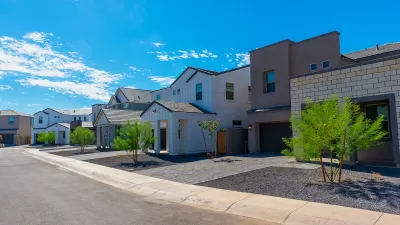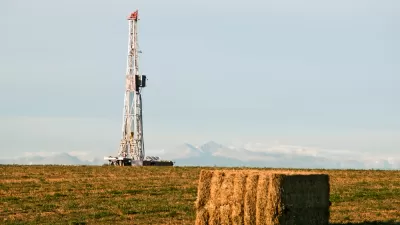Municipal setback requirements inconvenience pedestrians for no good reason.
Municipal zoning codes and comprehensive plans often require buildings to be set back far from the street. As a result, the metropolitan landscape sometimes looks like one giant strip mall; every building is separated from the street either by a parking lot or by some form of greenspace.
These rules inconvenience pedestrians in a variety of ways. First, setbacks artificially reduce density by reducing the amount of land available for housing and jobs. Since good transit service requires a minimal level of density (at least five units per acre for hourly bus service, and more for higher-quality bus service or rail), lower density means less transit service. Second, setbacks also force pedestrians to spend more time walking between buildings and sidewalks, thus making their commutes longer and more inconvenient. Third, setbacks make pedestrians feel less enclosed, making walking a less pleasant experience.
So why do cities still have these rules? Seattle's comprehensive plan makes a variety of arguments for mandatory setbacks. First, the plan claims that setbacks "ensure access to light and air." But all human beings breathe air no matter where buildings are placed, so "air" is irrelevant. Access to "light" also exists no matter where buildings are placed (with the possible exception of very tall buildings* that might cast shadows).
The plan also claims that setbacks create a "sense of privacy." This argument is so subjective that it is immune to verification. Having said that, I have lived in buildings that are near the sidewalk and those that are not, and I don't feel like I have any less privacy in the first situation.
Finally, the city claims that setbacks "provide adequate transition between zones of different intensities." This argument would justify setbacks for buildings at the border of two zones, but not for other buildings.
In sum, all of the city's arguments for setbacks appear to me to be unpersuasive.
*Living in midtown Manhattan, I notice that even streets occupied by very tall buildings (like Avenue of the Americas) sometimes have ample sunlight, depending on the time of the day and the side of the street at issue. So even in the "worst case scenario" of a skyscraper-dominated street, it is not true that buildings that front the sidewalk reduce sunlight.

Maui's Vacation Rental Debate Turns Ugly
Verbal attacks, misinformation campaigns and fistfights plague a high-stakes debate to convert thousands of vacation rentals into long-term housing.

Planetizen Federal Action Tracker
A weekly monitor of how Trump’s orders and actions are impacting planners and planning in America.

San Francisco Suspends Traffic Calming Amidst Record Deaths
Citing “a challenging fiscal landscape,” the city will cease the program on the heels of 42 traffic deaths, including 24 pedestrians.

Defunct Pittsburgh Power Plant to Become Residential Tower
A decommissioned steam heat plant will be redeveloped into almost 100 affordable housing units.

Trump Prompts Restructuring of Transportation Research Board in “Unprecedented Overreach”
The TRB has eliminated more than half of its committees including those focused on climate, equity, and cities.

Amtrak Rolls Out New Orleans to Alabama “Mardi Gras” Train
The new service will operate morning and evening departures between Mobile and New Orleans.
Urban Design for Planners 1: Software Tools
This six-course series explores essential urban design concepts using open source software and equips planners with the tools they need to participate fully in the urban design process.
Planning for Universal Design
Learn the tools for implementing Universal Design in planning regulations.
Heyer Gruel & Associates PA
JM Goldson LLC
Custer County Colorado
City of Camden Redevelopment Agency
City of Astoria
Transportation Research & Education Center (TREC) at Portland State University
Jefferson Parish Government
Camden Redevelopment Agency
City of Claremont





























